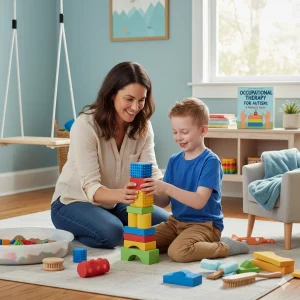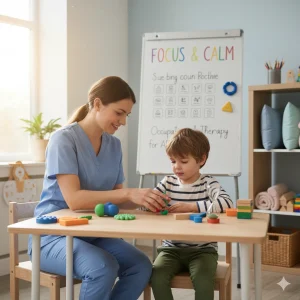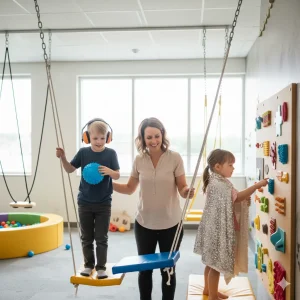0–12 Month Guide: Early Signs Baby Needs Occupational Therapy
By Wellness Hub
Last Updated: October 22, 2025
You know your baby best — so when something feels off, you notice it first. Maybe your little one still hates tummy time, stiffens during diaper changes, or seems slower to grasp and explore. These moments can make any parent wonder: “Is my baby just taking their time — or could something more be going on?”
The truth is, early signs that your child may need occupational therapy for baby development often appear quietly — in how they move, respond to touch, or handle everyday routines. The good news? Most of these challenges can be gently supported at home through simple, playful OT-based activities that help your baby feel calmer, stronger, and more connected.
The Early Signs & What You Can Do Today
Sometimes, the earliest clues that your baby might need a little extra help don’t look dramatic — they appear in small, everyday moments. You might notice your baby’s body feels unusually stiff or floppy, they startle easily, avoid touch, or cry during tummy time. These subtle patterns often hint that your baby’s nervous system is working extra hard to process movement and touch — something occupational therapy can gently support.
But take a deep breath — every baby develops at their own pace, and occasional fussiness or delays are completely normal. What matters is the pattern and persistence of these behaviors over time.
While you observe, you can start helping today with three simple, nurturing steps:
- Hold and Rock: Keep your baby close, skin-to-skin, and use slow, rhythmic rocking to build calm and body awareness.
- Tummy Time Alternatives: Try tummy time on your chest or across your lap — short, frequent, and always joyful.
- Gentle Touch Play: Massage arms and legs with your hands or a soft cloth to help your baby feel secure and connected.
If these signs continue for 4–6 weeks, or if your baby still struggles to settle, reach, or move comfortably, talk with your pediatrician or a pediatric occupational therapist. Early support can make everyday moments — feeding, play, cuddles — smoother and more enjoyable for both of you.
Also read: Baby Hates Tummy Time? Try These Expert OT Solutions
What Is Pediatric Occupational Therapy for Babies?
Pediatric occupational therapy (OT) helps babies build the foundation for everyday skills — from how they move and explore, to how they eat, play, and connect with the world around them. In simple terms, OT supports the way your baby’s brain and body work together so they can grow, learn, and thrive through play.
Unlike what the word “occupation” might suggest, a baby’s job isn’t work — it’s development. Through gentle, play-based activities, baby occupational therapy helps strengthen muscles, improve coordination, and fine-tune sensory processing (how your baby responds to touch, sound, and movement). It also supports self-regulation, helping babies calm down more easily, and feeding skills, like sucking, swallowing, and transitioning to solids.
OT sessions for infants are calm, engaging, and filled with playful interaction — using toys, songs, textures, and simple movements to encourage learning in a safe, positive way. Most importantly, occupational therapists work with parents, showing you how to turn daily routines — diaper changes, feeding, cuddles, and playtime — into powerful developmental moments.
Often, pediatric OTs collaborate closely with your pediatrician and other specialists, creating a coordinated plan that meets your baby’s unique needs. Together, the team focuses on helping your little one gain confidence, comfort, and curiosity in every stage of growth.
Early Signs by Age Band (0–12 Months)
Every baby grows on their own timeline — but when certain developmental milestones are consistently delayed, or daily routines like tummy time and play feel unusually hard, it can signal that your baby may benefit from occupational therapy (OT). Recognizing these signs early allows you to give gentle support before small challenges turn into bigger frustrations. Below is a month-by-month guide to help you spot common infant milestone red flags and understand when to check in with your pediatrician or an OT.
0–3 Months — When to Watch Closely
In the first three months, your baby is learning to adjust to the world — how to move, feel, and respond to comfort. Watch for patterns like:
- A body that feels very stiff or very floppy during holding or diaper changes.
- Persistent clenched fists or little movement of arms and legs.
- Difficulty soothing, even with gentle rocking or swaddling.
- Poor eye contact or lack of focus on your face.
- Crying or arching when placed on the tummy, even briefly.
Occasional fussiness is normal — but if these signs persist most days, your baby may need extra support building early sensory and motor control.
4–6 Months — Emerging Red Flags
By this stage, your baby’s strength and curiosity should start to blossom. If you notice the following, it might be time to keep a closer eye:
- Struggles to lift or hold the head steadily when on the tummy or in supported sitting.
- Not rolling from tummy to back or vice versa by around six months.
- Rarely brings hands to mouth or touches toys in front of them.
- Extreme reactions to normal touch, sound, or movement — arching, stiffening, or crying often.
- Avoids interaction or seems uncomfortable being held in new positions.
These can indicate your baby’s sensory system needs more help adjusting to new experiences — something an OT can gently guide through play-based movement and calming input.
7–9 Months — Motor & Sensory Concerns
During this stage, babies usually sit, reach, and start exploring their surroundings. Consider checking in if you see:
- Not sitting independently with hands free for play by nine months.
- Limited reaching, grasping, or transferring toys between hands.
- Avoidance of textures — refusing to touch soft toys or food.
- Constantly fussy or low in alertness, seeming tired or disengaged.
- Still prefers lying down instead of upright play.
These patterns can suggest motor planning or sensory processing difficulties — both areas occupational therapy can strengthen through fun, hands-on routines.
10–12 Months — Function & Play Skills
By one year, babies are building coordination and independence through movement and feeding. Keep an eye out for:
- Not crawling, scooting only on the belly, or struggling to pull to stand.
- Dropping toys often or not being able to pick up small objects between thumb and finger.
- Refusing self-feeding or gagging on textured foods.
- Limited babbling or playful imitation.
- Seems frustrated during play, gives up easily, or avoids exploration.
If your baby shows several of these signs, consider discussing an early occupational therapy evaluation. Early help focuses on play, bonding, and building skills naturally — not drills or pressure.
Learn more: Is Your 1-Year-Old Delayed? Occupational Therapy for 1-Year-Old
Common Red Flags Across the First Year (At Any Age)
While every baby grows at their own pace, some patterns are worth a closer look — especially when they continue month after month. These are not reasons to panic, but gentle signals that your baby’s sensory or motor systems might need extra support. Occupational therapy can help decode these patterns and build comfort through play and daily routines.
Here’s a simple checklist parents can use to spot infant sensory and developmental red flags that can appear at any time during the first year:
Persistent stiffness or floppiness:
Your baby’s body often feels either very tight and rigid or overly limp when held. They may struggle to relax during cuddles or diaper changes, or their movements seem less coordinated than expected.
Strong avoidance of touch, movement, or sound:
Your baby startles easily, cries during gentle rocking, or becomes upset by normal sounds like the vacuum or bathwater. These can be early sensory processing red flags, showing your baby’s brain needs more time to adapt to everyday sensations.
Ongoing feeding or gagging issues:
Frequent choking, gagging, or refusing textured foods may point to oral-motor or sensory challenges. If feeding always feels stressful or messy progress stalls after several weeks, an occupational therapist can assess swallowing, positioning, and sensory tolerance.
Read more: Does Your Child Need Feeding Therapy – Signs, Strategies & Support
Little interest in play or people:
If your baby rarely smiles back, avoids eye contact, or doesn’t show curiosity about toys or movement, it could signal difficulty engaging or regulating attention. Early social play helps build both language and motor skills, so noticing this early makes a big difference.
Hard to soothe or frequent inconsolable crying:
All babies cry — but constant fussiness, trouble calming even with consistent soothing, or frequent meltdowns may reflect overwhelm in the sensory system. With guided OT support, parents can learn calming input strategies that help their baby feel safe and secure.
Remember: noticing two or more of these signs repeatedly doesn’t mean something is “wrong.” It’s simply a cue to reach out — your pediatrician or a pediatric occupational therapist can gently evaluate what’s happening and suggest simple, home-based strategies. Early, playful intervention can make daily life smoother for both you and your little one.
Gentle Activities You Can Start Now (No Special Gear)
When you suspect your baby might be struggling with movement or sensory processing, the best thing you can do is start small — with loving, everyday routines that bring comfort and connection. These simple baby sensory activities don’t require any special equipment or training; they’re designed to help your baby feel calm, coordinated, and confident through play. A few minutes each day can make a big difference in your baby’s ability to explore and regulate their body.
Below are gentle, therapist-approved ideas to support your baby’s calming, sensory, and motor development right from home.
Calming & Regulation (Daily 5–10 Minutes)
When your baby feels calm and safe, their brain is ready to learn. Try these soothing sensory regulation activities once or twice a day:
Skin-to-Skin & Snug Holds – Hold your baby close against your chest. Gentle skin contact helps slow their heart rate and regulate breathing.
Slow, Rhythmic Rocking – Rock side to side or forward and back in a steady, predictable rhythm — this builds trust in movement and calms overstimulation.
Gentle Deep Pressure – Place your hands softly on your baby’s shoulders or arms and apply light, steady pressure. This helps with body awareness and can prevent startle reactions.
Add Familiar Sounds – Use soft humming, shushing, or white noise. Consistent sound cues help your baby recognize routine and relax faster.
Repeat Daily – Consistency is key; even short, predictable moments of calm signal safety to your baby’s developing nervous system.
Tummy-Time Without Tears
If tummy time has been a struggle, try these gentle alternatives to make it fun and safe:
Start on Your Chest – Lie back and place your baby tummy-down on your chest. Talk or sing softly so they focus on your face. Start with 20–30 seconds, a few times a day.
Use a Rolled Towel or Small Pillow – Place it under your baby’s chest to reduce strain. Support elbows under shoulders for comfort.
Stay Face-to-Face – Get on the floor with your baby and use mirrors or toys for encouragement.
Keep It Short & Sweet – Stop before your baby cries. Multiple short sessions (30 seconds to 2 minutes) work better than one long session.
Celebrate Progress – Each extra moment counts! Gradually increase duration as your baby gains strength and comfort.
Hands-to-Midline & Grasp Play
Bringing hands together and exploring toys strengthens coordination and fine motor skills — early building blocks for play, feeding, and self-soothing.
Midline Play – Gently guide your baby’s hands to meet at the center of their body while holding a soft rattle or cloth.
Offer Easy-to-Grip Toys – Choose lightweight rings or rattles that fit comfortably in small hands. Encourage grasping and letting go into a container.
Peek-a-Boo Practice – Use a thin scarf or burp cloth for peek-a-boo. This encourages reaching, pulling, and anticipation — all great for motor planning.
Switch Sides – Present toys to both left and right hands to promote balance and bilateral coordination.
Play Often – Short, frequent play sessions help develop confidence and hand control naturally.
Early Feeding Readiness (Non-Food Tolerance)
Helping your baby explore with their mouth safely builds the foundation for smooth feeding transitions later on.
Encourage Safe Mouthing – Offer clean, soft teethers of different firmness for your baby to explore. This improves oral awareness and desensitization.
Gentle Face & Cheek Massage – Use your fingertips to trace gentle circles on the cheeks and jaw before feeding — it improves muscle tone and comfort.
Messy Spoon Play – Let your baby mouth an empty spoon or explore puree textures with fingers. This normalizes contact and reduces gagging sensitivity.
Follow Your Baby’s Lead – Stop if they show discomfort and try again later. Repeated, low-pressure exposure works better than pushing too fast.
Celebrate Small Wins – Even touching food or a spoon to the lips counts as progress toward confident eating.
Parent Tip: These activities are most effective when done during calm, alert periods — not when your baby is hungry or overtired. Make it playful, watch their cues, and keep sessions short but consistent.
Know more: Unlocking Potential: How OT Empowers Kids to Thrive
Myths & Mistakes to Avoid
When it comes to your baby’s development, it’s easy to get mixed messages — from well-meaning relatives, parenting groups, or even social media. But understanding the facts about occupational therapy (OT) for babies can help you make confident, informed choices. Let’s clear up some common OT myths and parenting mistakes that can delay progress or add unnecessary stress.
“They’ll Grow Out of It” — Not Always True
Many parents are told to “wait and see” if their baby catches up — and while some mild delays do resolve naturally, others don’t. Babies who consistently show signs like stiffness, floppy tone, or sensory avoidance often benefit from gentle support now, not later. Early help doesn’t label your child — it gives their brain and body the best chance to build strong foundations through play. Think of OT as early coaching, not correction.
You Don’t Need Fancy Gear — Consistency Beats Intensity
You don’t need expensive toys, special mats, or complex equipment to help your baby thrive. Everyday items — a towel, soft rattle, mirror, or your arms — are often enough. What matters most is consistent, predictable interaction. Short daily routines where your baby feels safe, held, and encouraged will always beat rare, high-effort “therapy sessions.” The best results come from regular, nurturing play woven into normal family life.
Calm, Short Practices Work Better Than Long Sessions
Babies learn best when they’re calm, alert, and happy — not when they’re pushed to exhaustion. Keep activities short (2–5 minutes) and stop before your baby becomes fussy or tired. Gentle, positive experiences build trust and sensory tolerance far faster than forcing long or intense practice. Over time, those tiny, joyful moments add up to big developmental progress.
Skipping Early Intervention Can Slow Confidence
One of the biggest myths is that seeking OT means something is “wrong.” In reality, it’s about building confidence — for both you and your baby. Early guidance teaches parents how to recognize cues, adjust routines, and use play as therapy. The earlier you start, the easier it is to shape positive patterns that support feeding, movement, and social connection.
Parent Insight: Early support is not about labeling your child — it’s about empowering you. Occupational therapy helps you understand your baby’s signals and create experiences that feel safe, enjoyable, and growth-promoting.
Conclusion:
Every baby develops in their own time, but if you notice small delays or challenges, early help can make a big difference. Occupational therapy for babies uses gentle play and everyday routines to improve movement, comfort, and confidence. You don’t need special tools—just patience, love, and short, fun moments together. Early support helps your baby feel calm, connected, and ready to explore the world. Trust your instincts and reach out to your pediatrician or therapist if something feels off. With your care and consistency, your baby can grow stronger and happier every single day.
Frequently Asked Questions:
1. What are the earliest signs a baby might need OT?
Look for very stiff or very floppy tone, extreme startle, trouble calming, persistent tummy-time intolerance, and little interest in face-to-face play. One sign alone may be okay; a pattern over 4–6 weeks is a good reason to talk to your pediatrician or an OT.
2. How is OT different from physical therapy for babies?
Both support development through play. PT focuses more on big body movements and posture. OT focuses on sensory processing, fine motor, self-regulation, and early feeding. In practice, therapists collaborate and often work on overlapping skills during sessions.
3. When should I worry about tummy time refusal?
If your baby consistently cries despite very short, gentle attempts over 2–3 weeks, or still hates tummy time by 4–5 months, speak with your pediatrician. An OT can show pain-free positions, graded exposure, and calming strategies that make tummy time easier.
4. Can sensory issues show up in infants?
Yes. Strong reactions to routine touch, sound, or movement, or very low response to stimulation can appear in infancy. Patterns that persist or affect feeding, sleep, or play are worth discussing. Early OT uses gentle sensory input and routines to build tolerance.
5. What simple activities can I start today?
Try skin-to-skin, slow rocking, brief tummy time on your chest, easy-grip rings for midline play, and mouthing safe teethers before feeds. Keep sessions short, calm, and frequent. Stop before fussing escalates and try again later to build positive experiences.
6. Is it okay if my baby isn’t crawling by 10 months?
Some babies move differently, but by 10 months most are exploring with some form of floor mobility. If your baby shows little interest in moving or struggles to bear weight or coordinate arms, ask your pediatrician about an OT/PT referral for guidance.
7. How does OT help with early feeding problems?
OTs assess posture, oral-motor skills, and sensory responses. They introduce gentle oral massage, safe mouthing, and gradual texture exposure. Parents learn positioning and pacing to reduce gagging and stress. The goal is comfortable, confident feeding over time.
8. How many OT sessions does a baby usually need?
It varies. Some families benefit from a few parent-coaching visits; others need several months. Progress depends on the baby’s needs and home practice. Your therapist will set clear goals and update the plan as your baby gains skills in daily routines.
9. Do I need special equipment at home?
No. Pillows, towels, rattles, teethers, bowls, and your arms are enough. Consistent, joyful practice beats fancy tools. Your OT might suggest a few low-cost items if needed, but most activities use everyday things you already have.
10. Will therapy be uncomfortable for my baby?
OT is gentle and play-based. Therapists follow your baby’s cues and stop before distress rises. Short, positive experiences build trust and skills. If something seems uncomfortable, your therapist will adjust the plan and show you calmer alternatives.
About Author:
Sonali Sharma, Occupational Therapist
Sonali Sharma is a skilled Occupational Therapist at Wellness Hub, with over three years of experience in supporting children with developmental, behavioral, and learning challenges. She holds a Bachelor’s in Occupational Therapy (BOT) from Amity University and has worked with leading institutions such as NIMHANS Bengaluru and ESIC Hospital Faridabad.
At Wellness Hub, Sonali provides online occupational therapy sessions tailored to each child’s needs. She specializes in pediatric therapy, autism support, sensory integration, and developmental skill-building, helping children strengthen motor skills, improve focus, and become more independent in daily life.
Her therapy style is child-centered, play-based, and evidence-driven—making sessions both effective and enjoyable for kids. Sonali also equips parents with practical home therapy strategies to extend progress beyond sessions.
Passionate about empowering families, Sonali believes in creating a nurturing space where children can thrive while parents feel supported every step of the way.
Book your Free Consultation Today
Parent/Caregiver Info:
Client’s Details:
* Error Message









